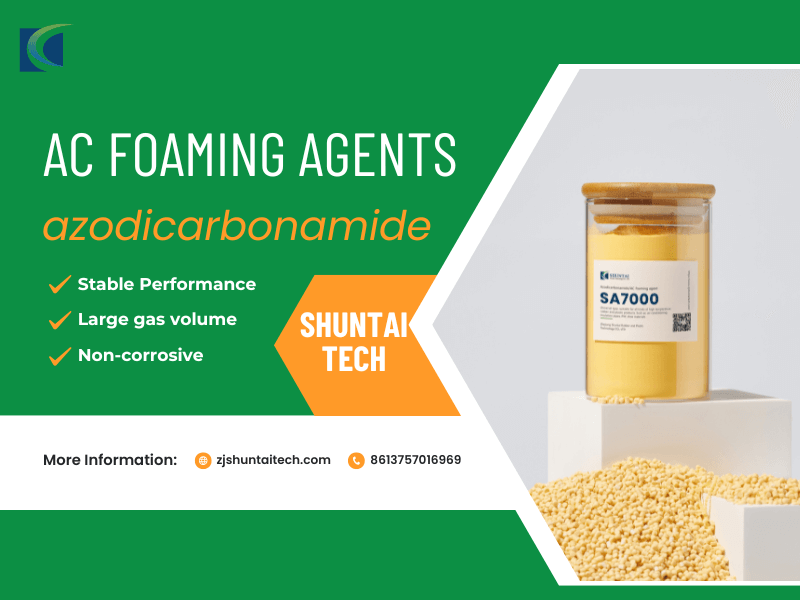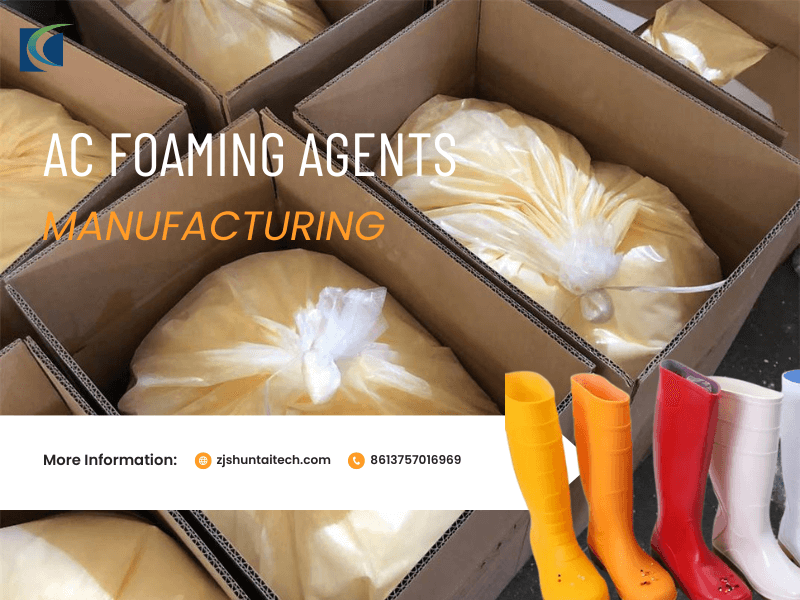In the current footwear market, PVC footwear occupies an important place by virtue of its price, variety of styles, wear-resistant and durable and many other advantages, and is loved by the majority of consumers. Whether it is casual shoes for daily wear or working shoes with special functions, PVC material can be seen.
In the production process of PVC footwear,
foaming agent plays an indispensable key role. In the production process of footwear, they can change the performance and form of PVC materials, so that the original ordinary PVC materials can be revitalized.
Definition and Classification of Foaming Agents

Basic Concept of Foaming Agents
Foaming agent is a kind of substance that can generate gas during material processing, thus forming a large number of bubbles inside the material and making the material have a porous structure. In the production of PVC footwear, it is this characteristic of foaming agents that gives PVC footwear its superior performance.
Classification of common blowing agents
Physical blowing agents: These blowing agents are usually liquids or gases with low boiling points, which are vaporized by heating to produce gas during the process, thus forming bubbles in PVC materials. Common physical blowing agents are Freon, propane, butane and so on.
Chemical blowing agents: Chemical blowing agents are substances that undergo a chemical reaction at a certain temperature and decompose to produce gas to realize foaming. According to its chemical composition and decomposition characteristics of different, can be divided into organic chemical blowing agent and inorganic chemical blowing agent. Organic chemical blowing agent such as azodicarbonamide, azodiisobutyronitrile, etc.; inorganic chemical blowing agent such as sodium bicarbonate, ammonium bicarbonate, etc.
Features of various Foaming Agents
Physical blowing agent: The foaming process is relatively mild, the bubbles produced are more uniform, and no residue is left in the material. However, the foaming ratio of physical blowing agent is relatively low, which is suitable for PVC footwear production with high requirements on foam structure and low requirements on foaming ratio, such as some sandals with smooth surface requirements.
Chemical blowing agent: the foaming ratio is higher, which can significantly reduce the density of the material and make PVC footwear lighter. However, chemical blowing agents may produce some by-products during the decomposition process, which may affect the performance and appearance of PVC footwear if not properly controlled. It is suitable for PVC footwear with high requirements for lightweight, such as the soles of sports shoes.
The importance of blowing agents in the production of PVC footwear

Improve the physical properties of PVC footwear
Lightweight: The bubbles produced by the blowing agent form a porous structure inside the PVC material, which greatly reduces the density of the material and makes PVC footwear lighter. This reduces the burden on the consumer's feet and improves wearing comfort, especially for long walks or sports.
Improved elasticity: The porous structure gives PVC materials better elasticity and resilience. When people walk or play sports in PVC shoes, the shoes are able to absorb impacts better, reducing injuries to the feet and joints and improving the overall wearing experience.
optimizes the appearance of PVC footwear
Surface texture: The use of foaming agents can change the surface texture of PVC footwear, making it softer, more delicate and better to the touch. Different foaming agents and foaming processes can also make the surface of PVC footwear show different textures and luster, which increases the aesthetics and attractiveness of the products.
Texture clarity: In the production of PVC footwear, the texture of the mold needs to be clearly reflected on the product in order to ensure the beauty and recognition of the product. The foaming agent can fill every corner of the mold during the foaming process, so that the PVC material can better fit the mold, thus making the grain of the footwear products clearer and more complete.
Reduce production cost and improve production efficiency
The use of foaming agent can reduce the amount of PVC resin under the premise of ensuring the performance of PVC footwear. Because the volume of foamed material increases, the amount of PVC resin required for the same volume of product decreases, thus reducing the cost of raw materials. At the same time, the foaming process is relatively simple and can be better connected with other production processes, improving the overall production efficiency.
Specific application process of foaming agent in PVC footwear production
Raw material preparation stage
In this stage, the key is to determine the proportion of PVC resin and blowing agent. The choice of ratio should be based on the performance requirements of the product, the type of blowing agent and the production process. If you want the product to have higher foaming times and better elasticity, you can appropriately increase the amount of blowing agent; if the strength of the product is required to be higher, you need to reduce the amount of blowing agent and increase the proportion of PVC resin. Generally speaking, the optimal proportion will be determined through several tests to ensure that the products produced meet the expected requirements.
Mixing stage
Mixing PVC resin, blowing agent and other auxiliary materials (such as stabilizers, plasticizers, coloring agents, etc.) is an important part to ensure the foaming effect. Mixing is usually carried out in a high-speed mixer, through mechanical stirring to make the various raw materials fully contact, fusion. In the mixing process, you need to control the mixing temperature and time, the temperature is too high may lead to early decomposition of the blowing agent, the temperature is too low will affect the mixing effect; time is too short raw materials are not mixed uniformly, time is too long will increase production costs.
Molding stage
The molding stage is the key period for the blowing agent to play a role. Mixed raw materials into the molding equipment (such as injection molding machines, extruders, etc.), in a certain temperature, pressure conditions, the raw material is gradually melted and plasticized. As the temperature rises, the blowing agent begins to decompose or vaporize to produce gas, forming a large number of bubbles in the molten PVC material. At this point, the molding temperature, pressure and time parameters need to be strictly controlled. Too high a temperature will lead to the decomposition of the blowing agent too quickly, resulting in too large and uneven bubbles, or even the phenomenon of burning; too low a temperature will not be able to give full play to the role of the blowing agent, the foaming effect is not good. Pressure control is also very important, the appropriate pressure can make the bubbles evenly distributed, to avoid bubble rupture.
Follow-up treatment stage
After the product is molded, the foaming effect needs to be checked, such as measuring the density of the product and observing the distribution of bubbles. If you find uneven foaming, foaming times do not meet the requirements and other issues, you need to make timely adjustments. For some products with surface defects, sanding, finishing and other treatments may also be required to improve the quality and appearance of the product. At the same time, the product is cooled and shaped to make its performance more stable.
Comparison of different types of blowing agents in PVC footwear production
Application effect and advantages and disadvantages of physical blowing agent
Application effect: PVC footwear produced with physical blowing agent has relatively uniform bubble distribution, smooth surface and soft texture. The foaming ratio is relatively low, and the strength and abrasion resistance of the products are better.
Advantages: the foaming process is mild, no harmful by-products, less impact on the environment and human body; bubble uniformity is good, the appearance of the product is of high quality.
Disadvantages: limited foaming times, difficult to produce a higher degree of lightweight products; higher requirements for production equipment and process conditions, production costs are relatively high.
Application effect and advantages and disadvantages of chemical foaming agent
Application effect: chemical foaming agent can produce higher foaming times, the lightweight effect of PVC footwear produced is remarkable, and the elasticity is better. However, the uniformity of bubble distribution is slightly worse than that of physical blowing agent.
Advantages: high foaming ratio, can greatly reduce the density of the product; wide range of application, can choose different types of chemical blowing agents according to different product requirements.
Disadvantages: the decomposition process may produce harmful gases and residues, which have a certain impact on the environment and product quality; the foaming process is not easy to control, and is prone to uneven foaming, bubble rupture and other problems.
Common problems and solutions in the application process of blowing agent
Uneven foaming problem
Causes: uneven mixing of raw materials, resulting in uneven distribution of blowing agent in the material; improper control of molding temperature, local temperature is too high or too low, so that the decomposition of the blowing agent or the speed of vaporization is inconsistent; raw materials contain impurities, affecting the role of the blowing agent to play.
Solution: Strengthen the control of the raw material mixing link to ensure that all kinds of raw materials are fully mixed evenly; optimize the molding temperature parameters, using segmented temperature control to ensure that the temperature of each part of the material is uniform; carry out strict screening and purification of raw materials to remove impurities.
Excessive or insufficient foaming
Excessive foaming: usually caused by too much foaming agent, too high molding temperature or too long time. Excessive foaming will cause the product to have problems such as bubble rupture and surface depression, which will affect the appearance and performance of the product.
Solution: Reduce the amount of foaming agent, lower the molding temperature or shorten the molding time.
Insufficient foaming: the main reason is that the amount of foaming agent is too small, the molding temperature is too low or the time is too short, and the quality of foaming agent is not good. Insufficient foaming will make the product too dense, lightweight effect is not obvious, poor elasticity.
Solution: Appropriately increase the amount of blowing agent, increase the molding temperature or extend the molding time, and replace the blowing agent with qualified quality.
Foaming agent compatibility with other auxiliary materials
Reason: the chemical properties of foaming agent and PVC resin, stabilizers, plasticizers and other auxiliary materials are quite different, resulting in they can not be well compatible with each other, thus affecting the foaming effect and product performance, delamination, cracking and other phenomena may occur.
Measures: Choose foaming agents with better compatibility with other auxiliary materials; add some compatibilizers to improve the compatibility between the foaming agent and other auxiliary materials; adjust the type and dosage of auxiliary materials, so that they can work better with the foaming agent.
Foaming agents have irreplaceable significance in the production of PVC footwear, especially the application of chemical foaming agents has injected a strong impetus for the development of the industry. Widely used azodicarbonamide (AC), with its high foaming multiplicity, can significantly reduce the density of PVC materials, so that sports shoes soles to achieve the desired lightweight effect; and nitroguanidine (NC), this kind of chemical blowing agent, in the process of decomposition, can produce uniform and delicate bubbles, to help improve the elasticity of the footwear products and the surface texture. These chemical blowing agents can not only improve the physical properties of PVC footwear - making them lighter and more elastic, but also optimize the appearance, making the texture of the footwear clearer and more outstanding. At the same time, through the rational selection of chemical blowing agents, the amount of PVC resin can be reduced under the premise of guaranteeing the quality of the product, effectively reducing production costs, and its good compatibility with the production process can also improve the overall production efficiency, which provides a solid guarantee for the diversified design and high-quality presentation of PVC footwear products, and promotes the continuous development of the whole industry.

